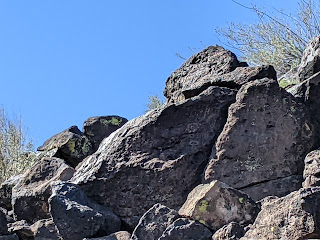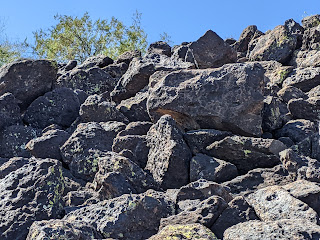I was excited when Steven discovered that the Deer Valley Petroglyph Preserve wasn't too far from our rental property in Phoenix last month. We'd been hiking daily at lots of parks in the north Phoenix area so the opportunity to do something way different was extra appealing.
Over the last few years, the preserve has incorporated indigenous plants, trees, shrubs, and cacti into the desert landscape in front of the entrance. Hummingbirds and monarch butterflies were just some of the many species that enjoy the garden flora.
The earliest petroglyphs found here are part of the Western Archais Tradition which represent petroglyph styles produced by hunter-gatherers across much of western North America, likely beginning around 3,000 BC here at Deer Valley. The people lived throughout the US Southwest and beyond depending on where they were able to locate food sources.
The majority of the petroglyphs made here at Deer Valley have been attributed to the Hohokam tradition, a term used to describe the settled agricultural populations of the northern Sonoran Desert about 450 and 1450 AD. The Hohokam people engaged in widespread trade across the region and built extensive canal systems to farm the desert and also built large villages in Phoenix and other areas. The Hohokam are among the ancestors of the contemporary O'odham communities in the Southwest.
We read in the Interpretive Center that some of the petroglyphs showed characteristics that were consistent with a third tradition: the Patayan found throughout western Arizona and southern California. The Patayan people lived in many regions, were skilled fishermen, hunters, and farmers.
Any modification of a rock surface, regardless of technique, is considered rock art. Here at Deer Valley's Hedgpeth Hills, there was one type of rock art: petroglyphs but there are different forms of rock art found all over the world at hundreds of thousands of sites. These images have been described as "windows to the worlds of ancient people and the values and concerns of their time." Rock art sites were carefully chosen. The images people created serve as important expressions of their ideas and belief systems, as well as messages about resources, territories, and events.
Petroglyphs are "pecked, incised, scratched, rubbed or grooved designs on a rock." By comparison, pictographs are painted designs on a rock surface using mineral or organic paint.
Looking at the petroglyphs, we had to wonder about the meaning of rock art as it couldn't be 'read' like a book or Egyptian hieroglyphs. Some of the symbols looked familiar, resembling people, animals, plants, the sun, etc. But it was important to take into account that simple designs may have complex meanings that depend on context.
Viewers were asked to consider whether the symbol of these two deer represented just the number of deer OR could it represent a group of people like a clan? OR might it mean an expression like 'swift as a deer'?
A question that came to mind was why did people make petroglyphs here? It's likely that no single explanation for the Hedgpeth Hills petroglyph site exists. However, this site can be compared to others in the Southwest and around the world. The comparisons can teach us how cultures share ideas and goods and also interact with each other. We can also learn lessons about human creativity and basic behavior.
Prehistoric people used both direct and indirect percussion techniques to make petroglyphs. Evidence showed that direct percussion at Hedgpeth Hills involved striking a rock surface with a harder rock, likely cobbles from nearby stream beds, washes and terraces as hammerstones.
Indirect percussion involved pecking into the surface of a rock with bones, antlers, and stones as chisels. Petroglyphs made with indirect percussion have smoother and better-designed edges because chisels allowed better control of the size and locations of individual pecks.
About 5,000 years ago, when people began visiting this area now known as the Hedgpeth Hills, they left their marks in the form of more than 1,500 petroglyphs pecked in the black basalt boulders.
As the Deer Valley Petroglyph Preserve is a sacred place to many indigenous people, visitors were asked not to run, yell, or disturb other visitors.
These petroglyphs were well known to the archaeological community and rock art fans but weren't formally recognized until a site survey, excavation, and documentation of the petroglyphs was completed in 1980. The interpretive center and walking path opened in 1994 under the auspices of Arizona State University.
These four boulders were relocated from where the adjacent Adobe Dam is located so it could be constructed.
The preserve's Amphitheater is used as a venue for local artists and musicians for demonstrations and performances because the Hedgpeth Hills create a unique acoustic experience.
The Hedgpeth Hills were a volatile source of volcanic rock for making manos and metates. The former were hand-held grinding tools used to crush grains, corn, and seed against the surface of the metates. While archaeologists found unfinished and broken manos and metates here at Hedgpeth Hills and at other sites in Arizona, they're still both used to grind food and other items in the Southwest and Mexico.
This boulder had one of the more common petroglyphs found throughout the Southwest: the concentric circle. Although seen often, its exact meaning is still a question.
After learning that this was rattlesnake habitat, we chose to stay on the path! As you can well imagine, Steven and I also paid attention to the warning that we be wary of bobcats and javelinas in the preserve.
The basalt rocks were formed 10 million years ago when fissures formed in the Earth's crust allowing lava to travel upwards through the crust and then break into large chunks as it cooled.
Some of the boulders had different colored spots. The red, green, and white spots weren't plants or paint but actually thirty species of lichen growing on the boulders.
Even with the lack of water, the Sonoran Desert is one of the most diverse ecosystems in the world. Plants and animals have adapted to survive in this harsh environment over thousands of years. If we'd been here a few weeks later, the desert would have been alive with colorful wildflowers.
The 'kissing deer' petroglyph is the symbol for the Deer Valley Petroglyph Preserve. Although that term has been coined, no one knows what its meaning was to those who made it. It's been speculated that it could be a deer drinking water, with the thinner deer being the reflection. Or are the deer fighting?
The majority of the Hedgpeth Hills petroglyphs were located on this hillside. According to researchers, they were made between 3,000 and 500 years ago with some clustered in panels and others alone on their own boulder. Researchers only know they were important to their creators, not what they meant or why they were placed here.
It was a real thrill seeing dozens of the petroglyphs spread across the hillside. Some looked like things we easily recognized, like animals, plants, and insects. Others that were were more abstract and geometric have been attributed to the Western Archaic Tradition who lived over 5,000 years ago.
At one viewpoint high above the trail were some of the most significant petroglyphs in the preserve. They looked to be two humanlike figures with large hands and feet. They looked just like stick figures that even I could draw! Archaeologists have used techniques ranging from photography to contextual comparisons to determine an age for the petroglyphs.
Everywhere we looked was a feast for the eyes in terms of the petroglyphs!
The highest petroglyph on the mountain was one that looked very much like a snake. One theory about the petroglyphs is that they could have been directional signs or signals for those traveling through the area.
The end of the petroglyph trail led past the Adobe Dam we'd heard about earlier. I found the Deer Valley petroglyphs to be of immense interest as they shed a new light for me on old civilizations that once made their home in the Southwest. Ahh, the stories these rocks could tell is all I could think!
Next post: The final post on our last couple of weeks in Phoenix - if you guessed more hiking opportunities, you're bang on!
Posted on March 22nd, 2022, from our home in Denver's burbs as we pack the final items in our bags before flying out at the ungodly hour of 5:45 am tomorrow for three-plus weeks in Hawaii and San Francisco. We were so hoping for some 'fun in the sun' but Steven just said the weather gods are going to throw rain at us for the next six days in Kauai! Oh well, here's hoping we'll be luckier in Maui and the Big Island.




































Happy trails on your next expedition in Hawaii!!! Janina
ReplyDeleteThanks Janina!
ReplyDelete